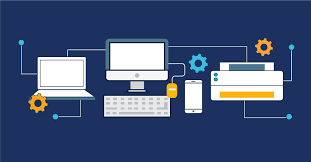Technology is all around us and has become an integral part of our lives. We use technology to communicate, work, entertain ourselves and even to help us stay healthy.
The most obvious example of technology in our everyday lives is the internet. We use it for almost everything – from searching for information to shopping, banking and socialising. It has become so important that it’s hard to imagine life without it.
Mobile phones are another form of technology that we rely on. They allow us to keep in touch with family and friends, no matter where we are in the world. Smartphones have taken this one step further by allowing us to access the internet on the go, as well as using apps for a variety of tasks such as navigation or ordering food.
Technology is also being used more and more in healthcare. Wearable devices like fitness trackers can monitor our heart rate and other vital signs which can be used by doctors to diagnose illnesses or provide advice on how to improve our health. There are also robots being developed that can assist with medical procedures such as surgery or delivering medication to patients in hospital wards.
Finally, technology is being used in education too. Schools now have access to interactive whiteboards which allow teachers to present lessons in a more engaging way than before, while online learning platforms provide students with access to educational materials from anywhere in the world.
Overall, it’s clear that technology has had a huge impact on our lives over the last few decades and will continue to do so as new developments emerge. It has allowed us to communicate more easily than ever before and opened up new opportunities for work, entertainment and healthcare – making life easier for people all over the world.
8 Frequently Asked Questions about Technologies in English (UK)
- Can we say technologies?
- What comes under technologies?
- What are the top 5 technologies?
- What are the top 5 technologies now?
- What are the 3 new technologies?
- What are 5 different technologies?
- What are the 5 technologies?
- What are called technologies?
Can we say technologies?
Yes, “technologies” is a grammatically correct plural form of the word “technology.” It is commonly used to refer to multiple types or instances of technology.
What comes under technologies?
Technologies can include a wide range of topics, such as:
-Computer hardware and software
-Networking and telecommunications
-Artificial intelligence
-Robotics
-Data science
-Cloud computing
-Internet of Things (IoT)
-Augmented reality (AR) and virtual reality (VR)
-Blockchain technology
-Cybersecurity
What are the top 5 technologies?
Artificial Intelligence (AI)
Blockchain
Internet of Things (IoT)
Cloud Computing
5. Augmented Reality (AR)
What are the top 5 technologies now?
Artificial Intelligence (AI)
Machine Learning (ML)
Cloud Computing
Internet of Things (IoT)
5. Blockchain
What are the 3 new technologies?
Artificial Intelligence (AI)
Internet of Things (IoT)
3. Virtual Reality (VR)
What are 5 different technologies?
Artificial Intelligence (AI)
Cloud Computing
Internet of Things (IoT)
Blockchain
5. Augmented Reality (AR)
What are the 5 technologies?
Artificial Intelligence (AI)
Cloud Computing
Internet of Things (IoT)
Big Data
5. Blockchain
What are called technologies?
Technologies are the application of scientific knowledge, tools, and techniques to solve practical problems or achieve specific objectives. They encompass a wide range of fields and disciplines, including but not limited to information technology, communication technology, medical technology, transportation technology, energy technology, and environmental technology.
Technologies can be physical devices or systems, software applications, processes or methods used in various industries and sectors. They often involve the use of machinery, equipment, computers, software programs, or advanced techniques to enhance productivity, efficiency, convenience, or effectiveness in different areas of human activity.
For example:
- Information Technology (IT): This includes computer hardware and software systems used for data storage and processing, networking technologies for communication purposes, internet technologies for online connectivity and access to information.
- Communication Technology: This refers to technologies that enable the transmission of information over long distances. It includes telecommunication systems like phones and satellites as well as internet-based communication platforms such as email and social media.
- Medical Technology: This encompasses a wide range of technologies used in healthcare settings for diagnosis, treatment, monitoring patient health conditions or managing medical records. Examples include medical imaging devices (X-ray machines), surgical robots or telemedicine platforms.
- Transportation Technology: This involves technologies used in transportation systems such as automobiles with advanced safety features (e.g., autonomous driving), high-speed trains or aircraft navigation systems.
- Energy Technology: These are technologies related to the generation and efficient use of energy resources. Examples include solar panels for renewable energy production or smart grids for optimizing energy distribution.
- Environmental Technology: These technologies focus on addressing environmental challenges such as pollution control systems (e.g., air filters), waste management solutions (recycling plants), or renewable energy sources.
These are just a few examples among countless technological advancements that have shaped our modern world. Technologies continue to evolve rapidly as scientists and innovators push the boundaries of what is possible in order to improve our lives and tackle global challenges.

